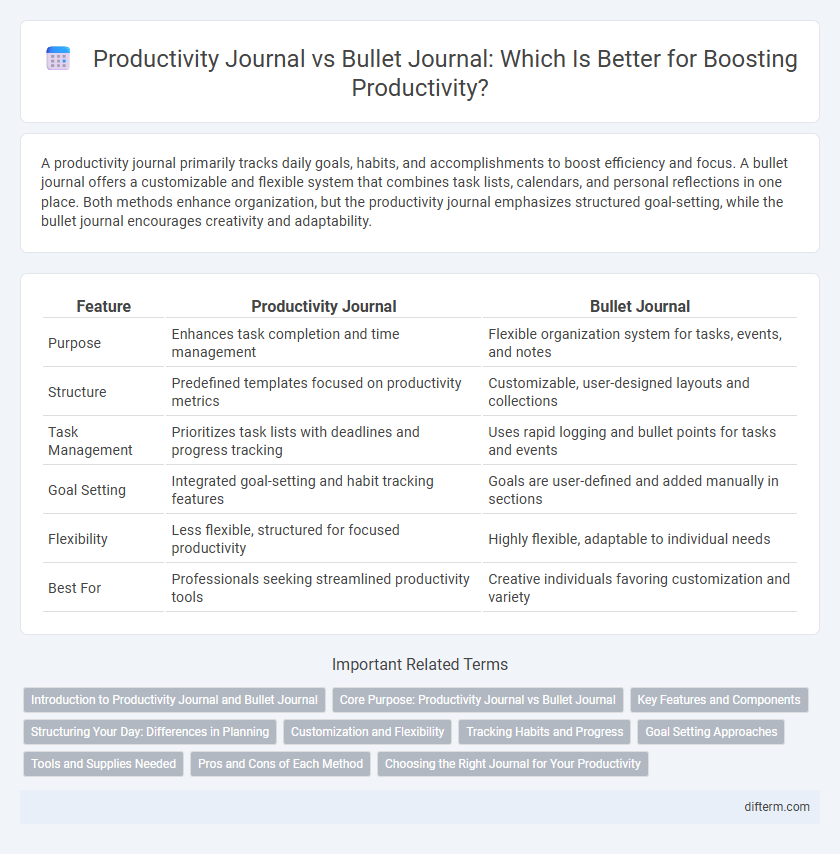A productivity journal primarily tracks daily goals, habits, and accomplishments to boost efficiency and focus. A bullet journal offers a customizable and flexible system that combines task lists, calendars, and personal reflections in one place. Both methods enhance organization, but the productivity journal emphasizes structured goal-setting, while the bullet journal encourages creativity and adaptability.
Table of Comparison
| Feature | Productivity Journal | Bullet Journal |
|---|---|---|
| Purpose | Enhances task completion and time management | Flexible organization system for tasks, events, and notes |
| Structure | Predefined templates focused on productivity metrics | Customizable, user-designed layouts and collections |
| Task Management | Prioritizes task lists with deadlines and progress tracking | Uses rapid logging and bullet points for tasks and events |
| Goal Setting | Integrated goal-setting and habit tracking features | Goals are user-defined and added manually in sections |
| Flexibility | Less flexible, structured for focused productivity | Highly flexible, adaptable to individual needs |
| Best For | Professionals seeking streamlined productivity tools | Creative individuals favoring customization and variety |
Introduction to Productivity Journal and Bullet Journal
A productivity journal is a structured tool designed to track goals, tasks, and progress systematically, enhancing time management and efficiency. In contrast, a bullet journal offers a flexible, customizable framework combining task lists, calendars, and mindfulness prompts to boost organization and creativity. Both methods support productivity improvement by fostering focus and intentional planning tailored to individual needs.
Core Purpose: Productivity Journal vs Bullet Journal
A Productivity Journal is designed specifically to enhance time management, goal tracking, and task prioritization through structured layouts and performance metrics, maximizing efficiency and output. In contrast, a Bullet Journal offers a flexible and customizable framework that combines task lists, calendars, and notes, promoting creativity and adaptability alongside productivity. Both systems serve distinct core purposes: the Productivity Journal emphasizes measurable productivity improvements, while the Bullet Journal fosters personal organization tailored to individual workflows.
Key Features and Components
Productivity journals emphasize structured goal setting, time blocking, and progress tracking with predefined templates to enhance efficiency. Bullet journals rely on customizable modules such as rapid logging, collections, and signifiers, allowing flexibility in task management and creativity. Key components in productivity journals include priority matrices and habit trackers, whereas bullet journals prioritize modularity and visual indexing for personalized organization.
Structuring Your Day: Differences in Planning
Productivity journals offer structured templates designed to set clear priorities, track goals, and monitor progress with measurable data, enhancing daily efficiency. Bullet journals provide a flexible, customizable approach that allows users to combine task lists, calendars, and notes in a single, personalized system tailored to individual needs. The primary difference lies in rigid structure versus adaptability, with productivity journals emphasizing systematic planning and bullet journals fostering creative organization.
Customization and Flexibility
The Productivity journal offers structured templates designed to enhance efficiency by guiding daily tasks and prioritization, ideal for users seeking a consistent organizational framework. In contrast, the Bullet journal provides unparalleled customization and flexibility, allowing individuals to create personalized layouts, track diverse goals, and adapt formats to their unique workflows. Both systems support productivity, but the Bullet journal excels in tailoring organization strategies to evolving personal needs.
Tracking Habits and Progress
Productivity journals emphasize data-driven tracking of habits and progress through structured templates, allowing for detailed analysis and goal measurement. Bullet journals offer flexible, customizable layouts that combine habit tracking with creative and reflective elements, fostering mindfulness. Both methods enhance productivity by promoting consistent self-monitoring and adaptive planning strategies.
Goal Setting Approaches
The Productivity journal emphasizes structured goal setting with clear deadlines, prioritizing tasks through the Eisenhower Matrix for enhanced focus and efficiency. Bullet journals offer flexible, customizable layouts that combine rapid logging with insightful reflection, allowing users to adapt their goal tracking to personal preferences. Integrating SMART goals in Productivity journals contrasts with the minimalistic, habit-tracking approach typical of Bullet journals, providing distinct methodologies for goal achievement.
Tools and Supplies Needed
The Productivity journal typically requires digital tools such as apps, timers, and cloud storage for task management and tracking, enhancing efficiency through integration with devices. Bullet journals demand physical supplies like dotted notebooks, pens, rulers, and markers, enabling customizable layouts and tactile interaction that boost creativity and focus. Choosing between these journaling methods depends on the preference for digital convenience or analog personalization, influencing the selection of essential tools and materials.
Pros and Cons of Each Method
The Productivity journal offers structured templates and goal tracking features that enhance focus and accountability, but may limit flexibility and creative expression. Bullet journals provide customizable layouts and encourage mindfulness through daily logging, yet can be time-consuming and require consistent effort to maintain. Choosing between them depends on whether you prefer a guided system for efficiency or an adaptable format for personal reflection.
Choosing the Right Journal for Your Productivity
Choosing the right journal for your productivity depends on your personal workflow and goal-setting style. A Productivity Journal often includes structured templates, time-blocking sections, and goal-tracking features designed to streamline task management and boost efficiency. In contrast, a Bullet Journal offers customizable layouts that encourage creativity and flexibility, making it ideal for users who prefer a more personalized approach to organizing their tasks and ideas.
Productivity journal vs Bullet journal Infographic

 difterm.com
difterm.com